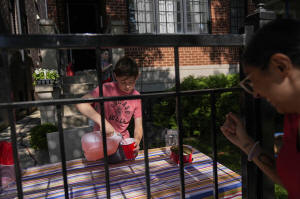How to stay cool in the heat wave hitting parts of the US — even without
air conditioning
[June 23, 2025]
By CALEIGH WELLS and MELINA WALLING
The first big heat wave of 2025 has arrived, coinciding with the
official start of summer.
More than 40 million people in the U.S. were under heat alerts Friday,
according to the National Weather Service. Temperatures in the Midwest
are expected to crest well into the 90s Fahrenheit (30s Celsius) this
weekend. Triple-digit highs could pop up in New York, Philadelphia,
Washington and Denver. The peak will likely hit the East Coast early
next week.
Meanwhile, British health officials are also issuing heat warnings for
the U.K.
Climate change has been exacerbating heat waves, and the problem isn't
going away any time soon. An increasingly hot planet — due largely to
burning fossil fuels such as coal, oil and natural gas — means already
hot regions are getting worse.
Heat doesn't just mean canceled events. It also poses a health risk,
especially for children, older people and those with certain health
conditions.
So here are some tips to stay safe.
When does heat become dangerous?
The answer depends on more than the temperature. The most detailed
measurement is called the wet bulb globe temperature (WBGT), which
includes temperature, humidity, cloud cover and wind. The heat index,
which measures temperature and humidity, is less descriptive but easier
to find on weather apps. Both explain why a shaded soccer field on a 90
degree F day (32 degree C) in arid Phoenix may be less risky than an
exposed park on an 80 degree F (27 degree C) day in soupy Little Rock.
Just based on heat index, NOAA has a chart that calculates how dangerous
prolonged exposure can be. For example, a day where temperatures reach
96 degree F (36 degrees C) and 45% humidity would fall into the “danger”
category for prolonged exposure or strenuous activity.
The WBGT threshold isn't exact, but recent research suggests that even
some young, healthy people can't endure hours of exposure to high heat
and humidity.
How to cool down
Overnight lows can be a particularly dangerous part of a heat wave, said
Ashley Ward, director of the Heat Policy Innovation Hub at Duke
University.
“Your body needs a reprieve,” she said. “You don't get that overnight,
we start the next day at a deficit.” Heat can worsen labor productivity
and lead to more visits to the emergency room.
“When we have overnight temperatures that don't drop below 75 degrees" F
(24 degrees C), she said, “You start to see some pretty extraordinary
outcomes with respect to heat illness and heat stroke, and even
mortality.”
Ward's answer: Find air conditioning. That might be at home, but she
said census data overcounts how many people have access.
If you can't afford to cool the whole house, Ward said, create a “cool
corner" and sleep there, so your body is prepared to tackle the next
day.
Evaporative or “swamp” coolers can help in dry heat, but they increase
humidity and can make it more difficult to cool down. In humid places,
just use a fan.
[to top of second column]
|

Robby, 12, who did not want to give his last name, sells lemonade in
his front yard on a hot Friday, June 20, 2025, in Chicago. (AP
Photo/Erin Hooley)
If you don't have air conditioning,
find public places that do, including movie theaters, malls and
libraries. Some communities set up cooling centers.
Depending on where you live, the Low-Income Home Energy Assistance
Program can help you buy a window air conditioning unit, according
to the National Council on Aging. Some local nonprofits and civic
organizations can also help you access one if cost is a burden.
Know your rights if you work outside
Knowing what workplace protections you have is important. But there
are no federal heat rules to protect workers in the United States.
Some states have them, including Washington, Oregon, California,
Nevada, Colorado, Minnesota and Maryland, according to the National
Resources Defense Council. Other states don't have any.
If your state has work rules, try to learn them — though there are
still challenges to ensuring regulations are actually enforced, said
Bharat Venkat, director of the University of California, Los Angeles
Heat Lab.
He notes that sometimes shaded areas are too far for workers to take
breaks without losing wages, or that management can make it
impossible for workers to advocate for themselves. “Most workers
don’t actually have control over their time or control over where
they work," he said.
Within those constraints, finding ways to stay hydrated and lower
your body temperature are paramount. You can do this by drinking
lots of fluids, wetting clothing or putting cold water or a cold rag
on your hands, feet, armpits and neck. A portable handheld fan or a
cooling vest can also help.
If you're exercising, avoid the hottest times of day and bring more
water than you think you need.
Knowing heat illness symptoms
Heat illness symptoms can vary by person, Venkat said. Medications
or underlying conditions can also make it harder to regulate body
temperature or notice you're getting too hot.
Early trouble signs include heavy sweating, muscle cramps and
headache. That's when you stop what you're doing and cool yourself
off — for example, by splashing yourself with cold water or finding
an air conditioned space.
As heat exhaustion sets in, new symptoms arrive, including faster
heart rate and dizziness. Next comes heat stroke, which can include
confusion, slurred words and fainting. Ward said that's when to call
911.
“Don’t be embarrassed to call 911 or go to urgent care when you
think you might have overdone it in the heat,” he said.
___
Walling reported from Chicago. Wells reported from Cleveland.
All contents © copyright 2025 Associated Press. All rights reserved |